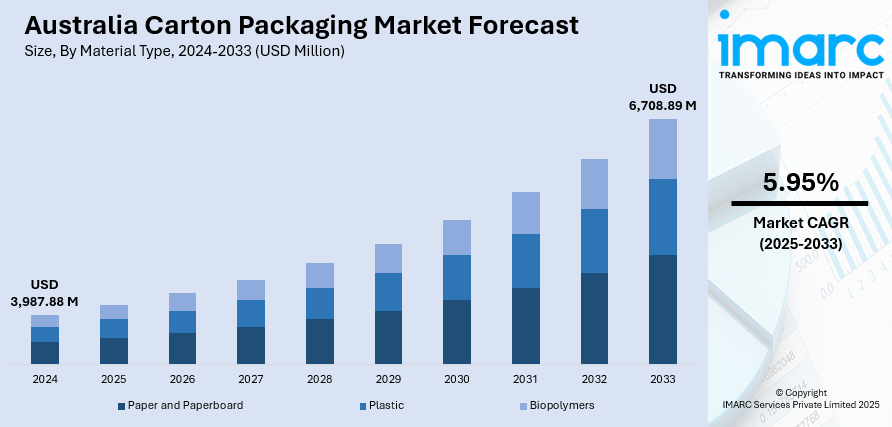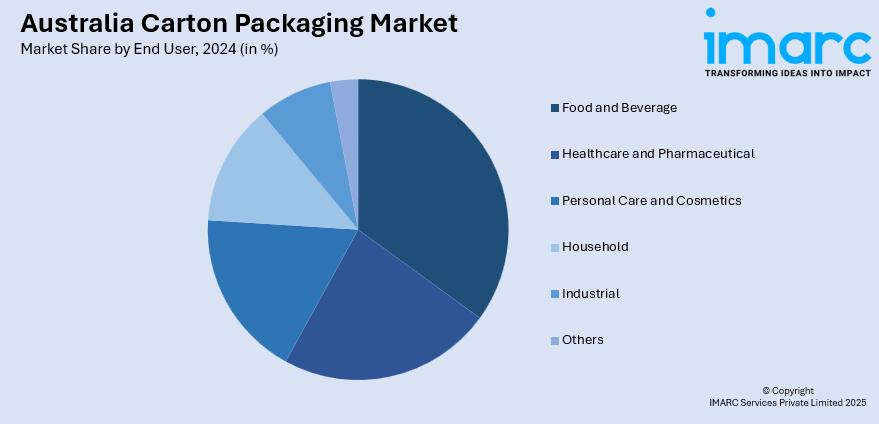
Australia Carton Packaging Market Size, Share, Trends and Forecast by Material Type, Product Type, End User, and Region, 2025-2033
Australia Carton Packaging Market Overview:
The Australia carton packaging market size reached USD 3,987.88 Million in 2024. Looking forward, IMARC Group expects the market to reach USD 6,708.89 Million by 2033, exhibiting a growth rate (CAGR) of 5.95% during 2025-2033. The market is witnessing significant growth driven by increasing demand from industries such as food and beverages, e-commerce, and consumer goods. The businesses shifting to eco-friendly materials and technological advancements in packaging design and production are also contributing to market expansion, leading to an increase in the Australia carton packaging market share.
|
Report Attribute
|
Key Statistics
|
|---|---|
|
Base Year
|
2024 |
|
Forecast Years
|
2025-2033
|
|
Historical Years
|
2019-2024
|
| Market Size in 2024 | USD 3,987.88 Million |
| Market Forecast in 2033 | USD 6,708.89 Million |
| Market Growth Rate 2025-2033 | 5.95% |
Australia Carton Packaging Market Trends:
Rising Focus on Sustainability
The demand for sustainable and eco-friendly carton packaging solutions is rapidly growing in Australia, driven by increasing environmental awareness among consumers and businesses. Companies are shifting towards recyclable, biodegradable, and compostable materials to reduce waste and minimize their carbon footprint. For instance, in September 2024, Detpak announced the launch of Australia’s largest range of over 20 commercially compostable PBS-lined cartons, trays, and lunchboxes to reduce single-use plastics. This new packaging aligns with recent legislation and ensures both kerbside recyclability and commercial composting certification, supporting businesses in adopting more sustainable packaging solutions. Materials like recycled paperboard, corrugated fiberboard, and biodegradable coatings are being used more frequently in packaging to replace traditional plastic-based alternatives. This shift not only helps in conserving natural resources but also aligns with stricter government regulations and industry standards on waste management and sustainability. Furthermore, companies are embracing sustainable packaging solutions to cater to the preferences of consumers who are more focused on environmental issues and prioritize sustainability when making their purchasing choices. As the focus on environmental impact intensifies, the push for recyclable and biodegradable packaging solutions continues to shape the future of the Australian carton packaging market.

To get more information on this market, Request Sample
Technological Innovations
Technological innovations are propelling the development in the Australia carton packaging market. Smarter, more innovative production methods are enhancing the strength, durability, and affordability of carton packaging. Automation and digital printing technologies are increasingly transforming packaging design, enabling increased personalization and more sophisticated graphics. In addition, artificial intelligence (AI) and data analysis are being used to improve manufacturing processes, minimize waste, and maintain accuracy in pack sizes. Advances in materials, including lighter but more durable corrugated cardboard, have also helped with more sustainable packaging while maintaining protective properties for goods transported. Such advances in carton design and manufacturing processes are not just making packaging more efficient but are also lowering manufacturing costs. For instance, in August 2024, IVE's folding carton announced that its business is on track to reach $90 million in annual revenue with the launch of its Sydney facility. The company invested USD 2.8 million in new equipment, projecting growth to USD150 million within five years, despite facing economic challenges affecting overall revenue and profit. With companies looking for improved, more effective packaging solutions, these technological advancements are contributing significantly to the Australia carton packaging market growth, setting it up for ongoing growth in the years to come.
Australia Carton Packaging Market Segmentation:
IMARC Group provides an analysis of the key trends in each segment of the market, along with forecasts at the country and regional levels for 2025-2033. Our report has categorized the market based on material type, product type, and end user.
Material Type Insights:
- Paper and Paperboard
- Plastic
- Biopolymers
The report has provided a detailed breakup and analysis of the market based on the material type. This includes paper and paperboard, plastic, and biopolymers.
Product Type Insights:
- Folding Cartons
- Rigid Cartons
- Liquid Cartons
A detailed breakup and analysis of the market based on the product type have also been provided in the report. This includes folding cartons, rigid cartons, and liquid cartons.
End User Insights:

- Food and Beverage
- Healthcare and Pharmaceutical
- Personal Care and Cosmetics
- Household
- Industrial
- Others
A detailed breakup and analysis of the market based on the end user have also been provided in the report. This includes food and beverage, healthcare and pharmaceutical, personal care and cosmetics, household, industrial, and others.
Regional Insights:
- Australia Capital Territory & New South Wales
- Victoria & Tasmania
- Queensland
- Northern Territory & Southern Australia
- Western Australia
The report has also provided a comprehensive analysis of all the major regional markets, which include Australia Capital Territory & New South Wales, Victoria & Tasmania, Queensland, Northern Territory & Southern Australia, and Western Australia.
Competitive Landscape:
The market research report has also provided a comprehensive analysis of the competitive landscape. Competitive analysis such as market structure, key player positioning, top winning strategies, competitive dashboard, and company evaluation quadrant has been covered in the report. Also, detailed profiles of all major companies have been provided.
Australia Carton Packaging Market News:
- In October 2023, Visy inaugurated a new corrugated cardboard box facility in Hemmant, Queensland, Australia, with a production capacity of one million boxes daily. The A$175 million factory aims to support food and beverage companies and is part of a broader A$2 billion investment in Australian packaging infrastructure over the next decade.
- In February 2023, Tetra Pak and saveBOARD opened Australia’s first food and beverage carton recycling facility in Warragamba, NSW. The plant will transform cartons into low carbon construction materials, supporting sustainability and the circular economy. It aims to reduce reliance on overseas recycling and promote eco-friendly practices in the construction industry.
Australia Carton Packaging Market Report Coverage:
| Report Features | Details |
|---|---|
| Base Year of the Analysis | 2024 |
| Historical Period | 2019-2024 |
| Forecast Period | 2025-2033 |
| Units | Million USD |
| Scope of the Report |
Exploration of Historical Trends and Market Outlook, Industry Catalysts and Challenges, Segment-Wise Historical and Future Market Assessment:
|
| Material Types Covered | Paper and Paperboard, Plastic, Biopolymers |
| Product Types Covered | Folding Cartons, Rigid Cartons, Liquid Cartons |
| End Users Covered | Food and Beverage, Healthcare and Pharmaceutical, Personal Care and Cosmetics, Household, Industrial, Others |
| Regions Covered | Australia Capital Territory & New South Wales, Victoria & Tasmania, Queensland, Northern Territory & Southern Australia, Western Australia |
| Customization Scope | 10% Free Customization |
| Post-Sale Analyst Support | 10-12 Weeks |
| Delivery Format | PDF and Excel through Email (We can also provide the editable version of the report in PPT/Word format on special request) |
Key Questions Answered in This Report:
- How has the Australia carton packaging market performed so far and how will it perform in the coming years?
- What is the breakup of the Australia carton packaging market on the basis of material type?
- What is the breakup of the Australia carton packaging market on the basis of product type?
- What is the breakup of the Australia carton packaging market on the basis of end user?
- What is the breakup of the Australia carton packaging market on the basis of region?
- What are the various stages in the value chain of the Australia carton packaging market?
- What are the key driving factors and challenges in the Australia carton packaging market?
- What is the structure of the Australia carton packaging market and who are the key players?
- What is the degree of competition in the Australia carton packaging market?
Key Benefits for Stakeholders:
- IMARC’s industry report offers a comprehensive quantitative analysis of various market segments, historical and current market trends, market forecasts, and dynamics of the Australia carton packaging market from 2019-2033.
- The research report provides the latest information on the market drivers, challenges, and opportunities in the Australia carton packaging market.
- Porter's five forces analysis assist stakeholders in assessing the impact of new entrants, competitive rivalry, supplier power, buyer power, and the threat of substitution. It helps stakeholders to analyze the level of competition within the Australia carton packaging industry and its attractiveness.
- Competitive landscape allows stakeholders to understand their competitive environment and provides an insight into the current positions of key players in the market.
Need more help?
- Speak to our experienced analysts for insights on the current market scenarios.
- Include additional segments and countries to customize the report as per your requirement.
- Gain an unparalleled competitive advantage in your domain by understanding how to utilize the report and positively impacting your operations and revenue.
- For further assistance, please connect with our analysts.
 Request Customization
Request Customization
 Speak to an Analyst
Speak to an Analyst
 Request Brochure
Request Brochure
 Inquire Before Buying
Inquire Before Buying




.webp)




.webp)












